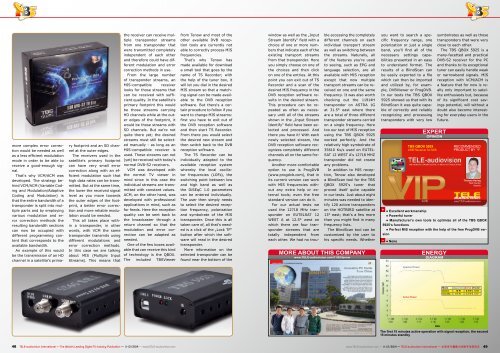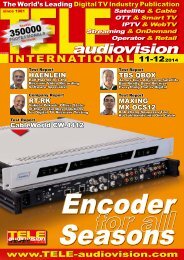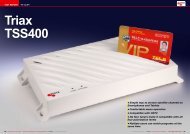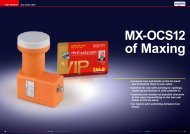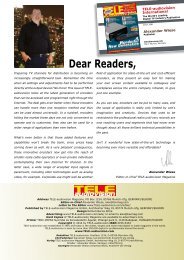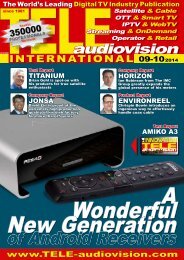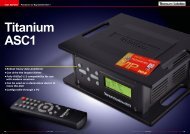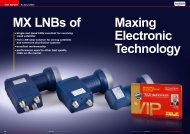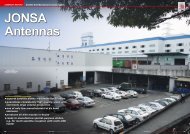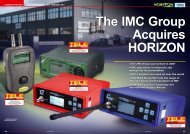TBS QBOX 5925
Create successful ePaper yourself
Turn your PDF publications into a flip-book with our unique Google optimized e-Paper software.
more complex error correction<br />
would be needed as well<br />
as a less efficient modulation<br />
mode in order to be able to<br />
receive a good-enough signal.<br />
That‘s why VCM/ACM was<br />
developed. The strategy behind<br />
VCM/ACM (Variable Coding<br />
and Modulation/Adaptive<br />
Coding and Modulation) is<br />
that the entire bandwidth of a<br />
transponder is split into multiple<br />
parts and by employing<br />
various modulation and error<br />
correction methods the<br />
resulting bandwidth sections<br />
can now be occupied with<br />
different programming content<br />
that corresponds to the<br />
available bandwidth.<br />
An example of this would<br />
be the transmission of an HD<br />
channel in a satellite‘s primary<br />
footprint and an SD channel<br />
at the outer edges.<br />
The receivers used in the<br />
satellite‘s primary footprint<br />
can have very small error<br />
correction along with an efficient<br />
modulation such that<br />
high data rates can be transmitted.<br />
But at the same time,<br />
the lower the received signal<br />
level as you move towards<br />
the outer edges of the footprint,<br />
a better error correction<br />
and more reliable modulation<br />
would be needed.<br />
This all takes place within<br />
a transponder, in other<br />
words, with VCM the same<br />
transponder transmits using<br />
different modulations and<br />
error correction methods.<br />
In this case we are talking<br />
about MIS (Multiple Input<br />
Streams). This means that<br />
the receiver can receive multiple<br />
transponder streams<br />
from one transponder that<br />
were transmitted completely<br />
independent of each other<br />
and therefore could have different<br />
modulation and error<br />
correction methods in use.<br />
From the large number<br />
of transponder streams, an<br />
MIS-compatible receiver<br />
looks for those streams that<br />
can be received with sufficient<br />
quality. In the satellite‘s<br />
primary footprint this would<br />
be those streams carrying<br />
HD channels while at the outer<br />
edges of the footprint, it<br />
would be those streams with<br />
SD channels. But we‘re not<br />
quite there yet; the desired<br />
streams must still be selected<br />
manually - as long as an<br />
MIS-compatible receiver is<br />
used. These streams can not<br />
(yet) be received with today‘s<br />
normal DVB-S2 receivers.<br />
VCM was developed with<br />
the normal TV viewer in<br />
mind since in this case the<br />
individual streams are transmitted<br />
with constant values.<br />
ACM, on the other hand, was<br />
developed with professional<br />
applications in mind, such as<br />
for feeds. Here the reception<br />
quality can be sent back to<br />
the broadcaster through a<br />
return channel so that the<br />
modulation and error correction<br />
can be adapted as<br />
needed.<br />
One of the few boxes available<br />
that can receive this kind<br />
of technology is the <strong>QBOX</strong>.<br />
The included <strong>TBS</strong>Viewer<br />
from Tenow and most of the<br />
other available DVB reception<br />
tools are currently not<br />
able to correctly process MIS<br />
frequencies.<br />
That‘s why Tenow has<br />
made available for download<br />
a small tool that goes by the<br />
name of TS Recorder; with<br />
the help of the tuner box, it<br />
will let you dial in the desired<br />
MIS stream so that a matching<br />
signal can be made available<br />
to the DVB reception<br />
software. But there‘s a certain<br />
procedure to follow if you<br />
want to change MIS streams:<br />
first you have to exit out of<br />
the DVB reception software<br />
and then start TS Recorder.<br />
From there you would select<br />
the desired new stream and<br />
then switch back to the DVB<br />
reception software.<br />
The TS Recorder can be<br />
individually adapted to the<br />
available reception system<br />
whereby the local oscillator<br />
frequencies (LOFs), the<br />
switching point between low<br />
and high band as well as<br />
the DiSEqC 1.0 parameters<br />
can be entered individually.<br />
The user then simply needs<br />
to select the desired reception<br />
frequency, polarization<br />
and symbolrate of the MIS<br />
transponder. Once this is all<br />
taken care of, all that‘s needed<br />
is a click of the „Lock TP“<br />
button after which the software<br />
will read in the desired<br />
transponder.<br />
More information on the<br />
selected transponder can be<br />
found near the bottom of the<br />
window as well as the „Input<br />
Stream Identify“ field with a<br />
choice of one or more numbers<br />
that indicate each of the<br />
existing transport streams<br />
from that transponder. Here<br />
you simply choose on one of<br />
the choices and then click<br />
on one of the entries. At this<br />
point you can exit out of TS<br />
Recorder and a scan of the<br />
desired MIS frequency in the<br />
DVB reception software results<br />
in the desired stream.<br />
This procedure can be repeated<br />
as often as necessary<br />
until all of the streams<br />
shown in the „Input Stream<br />
Identify“ field have been selected<br />
and processed. And<br />
there you have it! With each<br />
newly selected stream, the<br />
DVB reception software recognizes<br />
completely different<br />
channels all on the same frequency.<br />
Another more comfortable<br />
option to use is ProgDVB<br />
(www.progdvb.com), that in<br />
its current version can work<br />
with MIS frequencies without<br />
any extra help or external<br />
tools; even the free<br />
standard version can do it.<br />
For our actual tests we<br />
used the 12718 MHz transponder<br />
on EUTELSAT 12<br />
WEST A at 12.5° west on<br />
which there are four transponder<br />
streams that are<br />
totally independent from<br />
each other. We had no trouble<br />
accessing the completely<br />
different channels on each<br />
individual transport stream<br />
as well as switching between<br />
the streams. Naturally, all<br />
of the features you‘re used<br />
to seeing, such as EPG and<br />
language selection, are all<br />
available with MIS reception<br />
except that now multiple<br />
transport streams can be received<br />
on one and the same<br />
frequency. It was also worth<br />
checking out the 11914H<br />
transponder on ASTRA 1G<br />
at 31.5° east where there<br />
are a total of three different<br />
transponder streams carried<br />
on a single frequency. Here<br />
too our test of MIS reception<br />
using the <strong>TBS</strong> <strong>QBOX</strong> <strong>5925</strong><br />
worked perfectly. And the<br />
relatively high symbolrate of<br />
35610 Ks/s used on EUTEL-<br />
SAT 12 WEST A‘s 12718 MHZ<br />
transponder did not create<br />
any problems.<br />
In addition to MIS reception,<br />
Tenow also developed<br />
a BlindScan tool for the <strong>TBS</strong><br />
<strong>QBOX</strong> <strong>5925</strong>‘s tuner that<br />
proved itself quite capable<br />
in our tests. Just about eight<br />
minutes was needed to identify<br />
120 active transponders<br />
on the HOTBIRD satellite at<br />
13° east; that‘s a few more<br />
than you might find in many<br />
frequency lists.<br />
The BlindScan tool can be<br />
customized by the user to<br />
his specific needs. Whether<br />
More about this company<br />
www.TELE-audiovision.com/11/03/tenow<br />
you want to search a specific<br />
frequency range, one<br />
polarization or just a single<br />
band, you‘ll find all of the<br />
necessary settings capabilities<br />
presented in an easy<br />
to understand format. The<br />
results of a BlindScan can<br />
be easily exported to a file<br />
which can then be imported<br />
and utilized by, for example,<br />
DVBViewer or ProgDVB.<br />
In our tests the <strong>TBS</strong> <strong>QBOX</strong><br />
<strong>5925</strong> showed us that with its<br />
BlindScan it was quite capable<br />
of correctly and reliably<br />
recognizing and processing<br />
transponders with very low<br />
expert<br />
OPINION<br />
+ ● Excellent workmanship<br />
● Powerful tuner<br />
● Manufacturer‘s own tools to optimize all of the <strong>TBS</strong> <strong>QBOX</strong><br />
<strong>5925</strong>‘s functions<br />
● Perfect MIS reception with the help of the free ProgDVB version<br />
–<br />
● None<br />
<strong>TBS</strong> <strong>QBOX</strong> <strong>5925</strong><br />
USB Receiver for MIS<br />
ENERGY<br />
DIAGRAM<br />
symbolrates as well as those<br />
transponders that were very<br />
close to each other.<br />
The <strong>TBS</strong> <strong>QBOX</strong> <strong>5925</strong> is a<br />
many-facetted and practical<br />
DVB-S2 receiver for the PC<br />
and thanks to its exceptional<br />
tuner can easily handle weak<br />
or narrowband signals. MIS<br />
reception with VCM/ACM is<br />
a feature that for now is really<br />
only important to satellite<br />
enthusiasts but, because<br />
of its significant cost savings<br />
potential, will without a<br />
doubt also become interesting<br />
for everyday users in the<br />
future.<br />
RECOMMENDED<br />
PRODUCT BY<br />
Thomas Haring<br />
Test Center<br />
Austria<br />
Apparent Power<br />
Active Power<br />
Mode Apparent Active Factor<br />
Active 12 W 6.5 W 0.54<br />
StandBy 9.5 W 4.5 W 0.47<br />
The first 15 minutes active operation with signal reception, the second<br />
15 minutes standby<br />
48 TELE-audiovision International — The World‘s Leading Digital TV Industry Publication — 11-12/2014 — www.TELE-audiovision.com<br />
www.TELE-audiovision.com — 11-12/2014 — TELE-audiovision International — 全 球 发 行 量 最 大 的 数 字 电 视 杂 志 49


